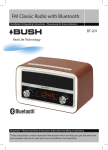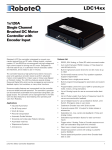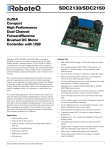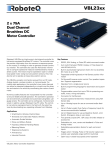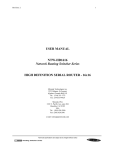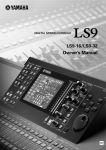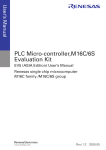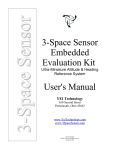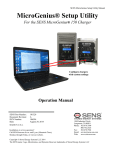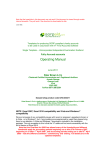Download ServoCenterMIDI 1.2 Manual
Transcript
User's Manual ServoCenterMidi v1.2a User's Manual & Programming Guide Yost Engineering, Inc. 630 Second Street Portsmouth, Ohio 45662 www.YostEngineering.com ©2002-2005 Yost Engineering, Inc. Printed in USA 1 TM User's Manual Table of Contents 1. Package Checklist........................................................................................................3 2. Function Overview......................................................................................................3 1.2 Introduction..................................................................................................................................3 2.2 Board Overview............................................................................................................................4 2.3 Features and Specifications.........................................................................................................6 2.3.1 Features.........................................................................................................................6 2.3.2 Specifications................................................................................................................6 Physical..............................................................................................................................6 Interface.............................................................................................................................6 Electrical............................................................................................................................6 3 Installation....................................................................................................................7 3.1 General Installation Precautions................................................................................................7 3.2 Connecting a Single ServoCenterMidi 1.2 Board.....................................................................7 3.3 Connecting Multiple ServoCenterMidi 1.2 Boards...................................................................8 3.4 Jumper Settings..........................................................................................................................10 3.4.1 Jumper JP1..................................................................................................................10 3.4.2 Jumper JP2..................................................................................................................10 3.5 MIDI Channel Settings..............................................................................................................11 4 Using the ServoCenterMidi 1.2.................................................................................12 4.1 ServoCenterMidi Usage Overview............................................................................................12 4.2 MIDI Implementation................................................................................................................13 4.1.2 Low Range Servo Mapping.........................................................................................13 4.2.2 High Range Servo Mapping........................................................................................14 4.2.3 Additional MIDI Controller Messages........................................................................15 4.2.4 Adjustable Pulse Width...............................................................................................15 4.2.5 Servo Smoothing Factor..............................................................................................15 5. Appendix....................................................................................................................16 5.1 Hexadecimal/Decimal/Binary Conversion Chart....................................................................16 2 User's Manual 1. Package Checklist When you purchase this product you receive the following items: • ServoCenterMidi 1.2 Controller Board • MIDI Cable • AC Adaptor ( 9VDC@1500ma, Positive Center) • ServoCenterMidi 1.2 User’s Manual & Programming Guide Attention: The ServoCenterMidi 1.2 Controller Board contains static sensitive devices. Avoid touching the circuitry on the board and always handle the board by the edges only. Caution: Fully read this instruction manual before operating the ServoCenterMidi 1.2. Misuse of the ServoCenterMidi 1.2 board could result in equipment damage or injury. 2. Function Overview 1.2 Introduction The ServoCenterMidi 1.2 is an embedded controller that allows any device with a MIDI ( Musical Instrument Digital Interface ) OUT port to control standard hobby servo motors via MIDI “Continuous Controller” messages. Each board provides for the MIDI Continuous Controller messages to easily control the seek position up to sixteen connected servos. The ServoCenterMidi controller also offers jumper selectable controller range setting, switch selectable MIDI channel settings, and flexible power options. The controller's ease of use and flexible feature set make ServoCenterMidi 1.2 especially useful for servo control applications such as robotics, animatronics, motion control, automation, retail displays, and other areas where MIDI music messages are to be coordinated with fluid servo motion. The broad range of MIDI sequencer software and MIDI controller devices make creating and storing servo motor motion performances easy for non-programmers. This opens up many opportunities for multimedia displays, interactive performance art, kinetic sculptures, advertising / retail displays, etc. Up to 16 motors can be connected to each ServoCenterMidi 1.2 board and up to 32 ServoCenterMidi 1.2 boards can be “daisy-chained” together thus allowing for a total of 512 RC servos to be controlled independently and simultaneously from one MIDI port. The ServoCenterMidi 1.2 controller is easily configured via jumper and switch settings and is easily programmed using MIDI Continuous Controller messages. 3 User's Manual 2.2 Board Overview 1. Power LED 13. Jumper JP2 2. Power Switch 12. Reset Button 11. Voltage Regulator 3. Power Supply Input 10. MIDI Channel 4. MIDI IN Connector 5. MIDI THRU connector 9. Jumper JP1 6. External Power Pads 8. Servo Connector 0-7 7. Servo Connector 8-15 1. Power LED – When the power is on the power LED will be lit. 2. Power Switch – The power switch is used to switch the controller board and the attached servos off. The board will also not pass information from the serial IN port to the serial THRU port when turned off. 3. Power Supply Input – Attach a 7-15VDC power source that can supply at least 1000ma supply current. The supply connector should be a 1.2mm x 5.5mm female connector with a positive center. 4. MIDI IN Connector – The controller receives its control messages from this port. This port is wired as a standard MIDI IN port and should be connected with a MIDI cable to the controlling device's MIDI OUT port or to the MIDI THRU port of another device in the MIDI chain. 5. MIDI THRU Connector – Messages received on the MIDI IN port are amplified and sent to the MIDI THRU port. This port allows other MIDI devices ( such as additional ServoCenterMidi boards or sound sources ) to be “daisy chained”. 6. External Power Pads – If a jumper is installed on position 1 of JP1 then these pads act as a source of external power which may be used to power additional servos or circuitry at either 4.8Vdc or 6.0Vdc. If the jumper at position 1 of JP1 is not installed then these pads may be used to connect an external servo power source such as a battery or higher current supply. 7. Servo Connector 8-15 – Servos 8 through 15 are connected here. The servos should always be connected so that the black ( ground ) wire of the servo is toward the outside edge of the board. 8. Servo Connector 0-7 – Servos 0 through 7 are connected here. The servos should always be connected so that the black ( ground ) wire of the servo is toward the outside edge of the board. 4 User's Manual 9. Jumper JP1 – Position 1 removes the on-board regulator's voltage from the servo connector when removed. It is necessary to remove this jumper when powering the servos from an external power source via the external power pads. Position 2 selects the MIDI Continuous Controller range that the board maps to the servos. When installed the servos are mapped to CC16-CC31; when not installed the servos are mapped to CC00-CC15. Position 3 selects the voltage level provided to the servos as follows: 4.8 volts when installed, 6.0 volts when removed. 10.MIDI Channel Switch – This switch determines the MIDI channel setting of the ServoCenterMidi controller board. When multiple boards are “daisy-chained” they can be distinguished from one another by using separate MIDI channel settings and CC range settings. 11.Voltage Regulator – This component supplies the power for all sixteen servos. During normal operation the regulator will get HOT. To avoid injury be careful not to touch the regulator during operation. To avoid fire do not allow combustible materials to contact the regulator during operation. The regulator circuit is equipped with both over-current and over-temperature shutdown circuitry. 12.Reset Button – This button allows the Servo Controller system to be reset without cycling the power. 13.Jumper JP2 – This jumper, when installed, allows the controller to receive MIDI messages. Removing this jumper allows a board to be disabled without physically changing the wiring of a MIDI daisy chain. 5 User's Manual 2.3 Features and Specifications 2.3.1 Features • Standard MIDI control via Continuous Controller messages. • Control position of all 16 servos simultaneously. • Control up to 16 RC servos per board. • Daisy-chain up to 32 boards to control up to 512 servos from one MIDI port. • On-board voltage regulator supports both 4.8 volt and 6.0 volt servo supply voltages. • Over-current / over-temperature protection. • Includes MIDI cable and 1500ma AC power supply. • Simple MIDI protocol makes motor control simple for non-programmers. • Jumper and switch settings allow for easy configuration. • • • MIDI Continuous Controller messages can control the position of the servos and whether each servo is on or off. Full 14-bit resolution allows for 16384 servo positions. Using ServoCenterMidi 1.2 with MIDI sequencer software allows for an instant motion control solution that allows accurate and repeatable recording and playback of servo motions. 2.3.2 Specifications Physical Size: 3.375”L x 3.625”W x 1.0”H (8.5cm L x 9.2cm W x 2.5cm H) Weight: 2.8 oz Interface Input Interface: 5-pin DIN MIDI-IN interface. Through Interface: 5-pin DIN MIDI-THRU interface. Data Format: MIDI Standard Interface running at 31.25kbps Servo Interface: 3-pin standard universal RC servo connector. Electrical Power Supply: 7.5VDC – 15VDC at no less than 1000ma. Power Jack: 1.2mm x 5.5mm Male Jack, Center Positive. Servo Power Output: Regulated 4.8VDC or 6.0VDC (selectable) 6 User's Manual 3 Installation 3.1 General Installation Precautions The ServoCenterMidi 1.2 board allows for several configuration options so that the user can select the option that best suits the particular requirement. In each configuration, however, the installation procedure is basically the same. When installing or configuring any ServoCenterMidi 1.2 board, observe the following: 1. Some of the electronic components are sensitive and can be damaged by electro-static discharge. Avoid touching the circuitry on the board itself and handle the board only by the edges. Place the board in a static shielding bag when storing the board for extended periods. 2. Use only the AC adaptor that was provided with the ServoCenter board. If an alternate power supply is used ensure that it is of appropriate voltage, amperage and polarity for the board. 3. When making changes in wiring, configuration, and jumper settings, be careful not to touch the voltage regulator/heat-sink. These components get hot and may cause injury if contacted. 4. The regulator and heat-sink of the ServoCenter controller get HOT during periods of heavy utilization. Avoid placing the ServoCenter board in enclosed spaces or in close proximity to combustible materials. 5. When connecting servo motors be careful to observe the polarity of the servo connectors. The black wire should be connected toward the outside edge of the board. Failure to observe the proper connector polarity could result in damage to the ServoCenter board and/or the incorrectly connected servos. 6. If an external power source such as an alternate power supply or battery is connected to the PWR connector, ensure that the jumper on position 1 of JP1 is removed. 3.2 Connecting a Single ServoCenterMidi 1.2 Board Follow these steps to connect a single ServoCenterMidi 1.2 board. 1. Connect the MIDI-IN port of the ServoCenterMidi board to the MIDI OUT port of the controller ( i.e. Keyboard or other MIDI device ). 2. Connect from 1 to 16 servos to the ServoCenter board’s servo ports. 3. Ensure that jumper settings are correct. ( See Section 3.4 ) 4. Ensure that the MIDI Channel setting is correct. Generally MIDI Channel 1 is used in single board applications, but any MIDI Channel can be used. ( See Section 3.5 ) 5. Connect the provided 9VDC@1500ma power supply to the ServoCenter board. 7 User's Manual 9VDC Adaptor MIDI Cable MIDI Device Servo Servo . . . Servo Connecting a Single ServoCenterMidi 1.2 Controller 3.3 Connecting Multiple ServoCenterMidi 1.2 Boards ServoCenterMidi 1.2 can support up to 32 boards with unique servo configurations connected together in a “daisy-chain” arrangement. This expandability allows for distinct and precise control of up to 512 servo motors. The ServoCenter boards can be identified from one another in two ways: by assigning each board a unique MIDI Channel and/or by assigning each a different MIDI Continuous Controller range. The MIDI Channel setting is determined by the block of four switches located on the ServoCenter board. The MIDI Continuous Controller range is determined by jumper position 2 on jumper JP1. Complete the following steps to connect multiple ServoCenterMidi 1.2 Boards: 1. Connect the MIDI-IN port of the first ServoCenter board to the MIDI-OUT port of the controlling device using a standard MIDI cable. 2. Connect the MIDI-IN port of the next ServoCenter board to the MIDI-THRU port of the previous ServoCenter board. Repeat this step for all other boards. 3. Set the MIDI Channel switches and CC Range jumpers for each board to the desired settings. This is important because this setting is what the controlling device will use to deliver commands to specific servos on specific controller modules. 4. Connect the provided 9VDC@1500ma power supplies to each ServoCenter board. Each module should be connected with a separate power supply. 5. Connect from 1 to 16 servo motors to each of the connected ServoCenter boards. 8 User's Manual 9VDC Adaptor MIDI Device MIDI Cable Servo Servo . . . Servo 9VDC Adaptor Servo Servo . . . MIDI Cable Servo Connecting Multiple ServoCenterMidi 1.2 Controllers Note: While ServoCenterMidi 1.2 will support up to 16 unique MIDI Channels in a “daisy-chain” and two CC ranges, any number of ServoCenter boards may be assigned the same MIDI Channel and CC range. The result of this will be that all boards with the same MIDI Channel and CC range will simultaneously move their respective servos to the same positions. This can be done to obtain synchronized multiple servo movements or to divide high current servos across multiple boards without consuming additional board IDs. 9 User's Manual 3.4 Jumper Settings The ServoCenterMidi 1.2 board has two sets of jumpers to allow various flexible software and hardware control configurations. The functionality exhibited by these jumper banks (Section 2.2 Items 9, 13) when a jumper is installed is described in each of the sections below. 3.4.1 Jumper JP1 The specific functionality of jumper JP1 is as follows: Jumper JP1 Position Effect of Jumper When Installed 1 Internal regulated servo power is connected to the servo connectors. 2 MIDI Continuous Controller range CC16-CC31 is assigned rather than CC00-CC15. 3 Servo voltage select. Regulated servo power is set to 4.8VDC when installed and 6.0VDC when removed. When a jumper is installed in position 1, the on-board regulator supplies power to the servo connectors. When the jumper is removed from this position the regulated power is disconnected from the servo connectors. This jumper should be removed if an external power source such as a battery is used to provide the servo power via the “external power connection”. Removal of this jumper can also act as a quick method of removing power from the servos without disconnecting their wires. To avoid damage, never connect an external power source to the “external power connection” while this jumper is installed. When a jumper is installed in position 2, servos S0 through S15 are assigned to MIDI Continuous Controller CC16-CC31 respectively. When the jumper is removed from this position servos S0 through S15 are assigned to MIDI Continuous Controller CC00CC15 respectively. This allows two boards to share the same MIDI channel and allows the ServoCenterMidi controller to share a MIDI channel with another device. When a jumper is installed in position 3, the on-board regulator provides 4.8VDC. When the jumper is removed from this position then the regulator provides 6.0VDC. 3.4.2 Jumper JP2 Jumper JP2 controls the reception of MIDI messages by the controller. The specific functionality of jumper JP2 is as follows: Jumper JP2 Position Effect of Jumper When Installed 1 Controller receives control messages from the MIDI-IN port. Jumper JP2, when installed, allows the controller to receive MIDI messages. Removing this jumper allows a board to be disabled without physically changing the wiring of a MIDI daisy chain. 10 User's Manual 3.5 MIDI Channel Settings The board's MIDI Channel is set via the blue bank of switches located in the upper left corner of the ServoCenterMidi 1.2 board (see Board Overview – Section 2.2 item 10). MIDI Channel numbers are determined by the position of each switch in the bank. The settings of the switch indicate the binary representation of the MIDI Channel ID number. Refer to the table below regarding the switch position/MIDI Channel relationship. Board Identification Settings 1 2 3 4 MIDI Channel Off Off Off Off 1 Off Off Off On 2 Off Off On Off 3 Off Off On On 4 Off On Off Off 5 Off On Off On 6 Off On On Off 7 Off On On On 8 On Off Off Off 9 On Off Off On 10 On Off On Off 11 On Off On On 12 On On Off Off 13 On On Off On 14 On On On Off 15 On On On On 16 MIDI Channel settings can be changed any time during the operation of the ServoCenterMidi 1.2. 11 User's Manual 4 Using the ServoCenterMidi 1.2 4.1 ServoCenterMidi Usage Overview The ServoCenterMidi 1.2 controller receives messages from the controlling MIDI device in the form of MIDI messages. The ServoCenter only responds to MIDI Continuous Controller messages and all other MIDI messages are ignored. MIDI Continuous Controller messages are 3-bytes in length and have the following format: Binary Format Decimal Range Description 1011cccc 176~191 cccc is the MIDI channel of the message. 0nnnnnnn 0~127 nnnnnnn is the continuous controller number to be changed. 0vvvvvvv 0~127 vvvvvvv is the value to which the controller should be changed. Since each controller message has only a 7-bit value field, many MIDI devices ( such as the ServoCenterMidi ) utilize some controllers in pairs to achieve a full 14-bit resolution. These can be thought of as the “coarse” adjustment for the most significant 7-bits (MSB), and the “fine” adjustment for the least significant 7-bits (LSB). Other controllers operate as switches to turn a particular parameter either off or on. This is done by treating any value greater than or equal to 64 as “on” and any value of 63 or less as “off”. The ServoCenterMidi device uses both of these concepts to control the position and the on/off state of each motor independently. The MIDI standard defines 32 of these 14-bit continuous controllers with 00 through 31 being the “coarse” (MSB) and 32 through 63 being the “fine”(LSB) of the value respectively. The ServoCenterMidi 1.2 uses position 2 of jumper JP1 to map these standard controllers to the motor positions of the 16 servo motors. When the jumper is removed the motors are mapped to controller 00-15 for coarse control and 32-47 for fine control. When the jumper is installed the motors are mapped to controller 16-31 for coarse control and 48-63 for fine control. If only coarse control is desired the fine controls can be ignored. See section 4.2 for specific implementation details. ServoCenterMidi 1.2 can also turn motors on and off by using controllers 64 through 95. Controllers 64-79 turn on/off motors mapped into the 00-15 range while controllers 80-95 turn on/off motors mapped into the 16-31 range. See section 4.2 for specific implementation details. When the board is powered on or reset, the motors, by default, are in the “off” state, meaning that they are sent no control signal and will freely turn. A motor remains in the off state until either a MIDI controller message is received for that motor or a motor on message is received for that motor. Motors that are in the “on” state will remain on ( meaning that they'll actively hold their position ) until that motor receives a motor off message or the board is reset. 12 User's Manual 4.2 MIDI Implementation 4.1.2 Low Range Servo Mapping When position 2 of jumper JP1 is not installed the motors are mapped to the low continuous controller range according to the following table: Controller Number Standard MIDI Use ServoCenterMidi Use 00 Bank Select MSB Servo S0 Coarse (MSB) 01 Modulation Wheel MSB Servo S1 Coarse (MSB) 02 Breath Controller MSB Servo S2 Coarse (MSB) 03 Undefined MSB Servo S3 Coarse (MSB) 04 Foot Controller MSB Servo S4 Coarse (MSB) 05 Portamento Time MSB Servo S5 Coarse (MSB) 06 Data Entry MSB Servo S6 Coarse (MSB) 07 Channel Volume MSB Servo S7 Coarse (MSB) 08 Balance MSB Servo S8 Coarse (MSB) 09 Undefined MSB Servo S9 Coarse (MSB) 10 Pan MSB Servo S10 Coarse (MSB) 11 Expression Controller MSB Servo S11 Coarse (MSB) 12 Effect Control MSB Servo S12 Coarse (MSB) 13 Effect Control MSB Servo S13 Coarse (MSB) 14 Undefined MSB Servo S14 Coarse (MSB) 15 Undefined MSB Servo S15 Coarse (MSB) 32 Bank Select LSB Servo S0 Fine (LSB) 33 Modulation Wheel LSB Servo S1 Fine (LSB) 34 Breath Controller LSB Servo S2 Fine (LSB) 35 Undefined LSB Servo S3 Fine (LSB) 36 Foot Controller LSB Servo S4 Fine (LSB) 37 Portamento Time LSB Servo S5 Fine (LSB) 38 Data Entry LSB Servo S6 Fine (LSB) 39 Channel Volume LSB Servo S7 Fine (LSB) 40 Balance LSB Servo S8 Fine (LSB) 41 Undefined LSB Servo S9 Fine (LSB) 42 Pan LSB Servo S10 Fine (LSB) 43 Expression Controller LSB Servo S11 Fine (LSB) 44 Effect Control LSB Servo S12 Fine (LSB) 45 Effect Control LSB Servo S13 Fine (LSB) 46 Undefined LSB Servo S14 Fine (LSB) 47 Undefined LSB Servo S15 Fine (LSB) 64 Damper Pedal On/Off Servo S0 On/Off 65 Portamento On/Off Servo S1 On/Off 66 Sustenuto On/Off Servo S2 On/Off 67 Soft Pedal On/Off Servo S3 On/Off 68 Legato Footswitch On/Off Servo S4 On/Off 69 Hold 2 On/Off Servo S5 On/Off 70 Sound Controller 1 Servo S6 On/Off 71 Sound Controller 2 Servo S7 On/Off 72 Sound Controller 3 Servo S8 On/Off 73 Sound Controller 4 Servo S9 On/Off 74 Sound Controller 5 Servo S10 On/Off 75 Sound Controller 6 Servo S11 On/Off 76 Sound Controller 7 Servo S12 On/Off 77 Sound Controller 8 Servo S13 On/Off 78 Sound Controller 9 Servo S14 On/Off 79 Sound Controller 10 Servo S15 On/Off 114 Undefined Set Pulse Width Min 115 Undefined Set Pulse Width Max 116 Undefined Set Smoothing Factor Note that a motor is turned on whenever one of its corresponding controllers is changed and will seek to its set position. 13 User's Manual 4.2.2 High Range Servo Mapping When position 2 of jumper JP1 is installed the motors are mapped to the high continuous controller range according to the following table: Controller Number Standard MIDI Use ServoCenterMidi Use 16 General Purpose 1 MSB Servo S0 Coarse (MSB) 17 General Purpose 2 MSB Servo S1 Coarse (MSB) 18 General Purpose 3 MSB Servo S2 Coarse (MSB) 19 General Purpose 4 MSB Servo S3 Coarse (MSB) 20 Undefined MSB Servo S4 Coarse (MSB) 21 Undefined MSB Servo S5 Coarse (MSB) 22 Undefined MSB Servo S6 Coarse (MSB) 23 Undefined MSB Servo S7 Coarse (MSB) 24 Undefined MSB Servo S8 Coarse (MSB) 25 Undefined MSB Servo S9 Coarse (MSB) 26 Undefined MSB Servo S10 Coarse (MSB) 27 Undefined MSB Servo S11 Coarse (MSB) 28 Undefined MSB Servo S12 Coarse (MSB) 29 Undefined MSB Servo S13 Coarse (MSB) 30 Undefined MSB Servo S14 Coarse (MSB) 31 Undefined MSB Servo S15 Coarse (MSB) 48 General Purpose 1 LSB Servo S0 Fine (LSB) 49 General Purpose 2 LSB Servo S1 Fine (LSB) 50 General Purpose 3 LSB Servo S2 Fine (LSB) 51 General Purpose 4 LSB Servo S3 Fine (LSB) 52 Undefined LSB Servo S4 Fine (LSB) 53 Undefined LSB Servo S5 Fine (LSB) 54 Undefined LSB Servo S6 Fine (LSB) 55 Undefined LSB Servo S7 Fine (LSB) 56 Undefined LSB Servo S8 Fine (LSB) 57 Undefined LSB Servo S9 Fine (LSB) 58 Undefined LSB Servo S10 Fine (LSB) 59 Undefined LSB Servo S11 Fine (LSB) 60 Undefined LSB Servo S12 Fine (LSB) 61 Undefined LSB Servo S13 Fine (LSB) 62 Undefined LSB Servo S14 Fine (LSB) 63 Undefined LSB Servo S15 Fine (LSB) 80 General Purpose 5 Servo S0 On/Off 81 General Purpose 6 Servo S1 On/Off 82 General Purpose 7 Servo S2 On/Off 83 General Purpose 8 Servo S3 On/Off 84 Undefined Servo S4 On/Off 85 Undefined Servo S5 On/Off 86 Undefined Servo S6 On/Off 87 Undefined Servo S7 On/Off 88 Undefined Servo S8 On/Off 89 Undefined Servo S9 On/Off 90 Undefined Servo S10 On/Off 91 Effects 1 Depth Servo S11 On/Off 92 Effects 2 Depth Servo S12 On/Off 93 Effects 3 Depth Servo S13 On/Off 94 Effects 4 Depth Servo S14 On/Off 95 Effects 5 Depth Servo S15 On/Off 117 Undefined Set Pulse Width Min 118 Undefined Set Pulse Width Max 119 Undefined Set Smoothing Factor Note that a motor is turned back on whenever one of its corresponding controllers is changed. Motors turned off and then turned back on will seek to the previous set position of that motor before it was turned off. 14 User's Manual 4.2.3 Additional MIDI Controller Messages The ServoCenterMidi board also responds to several standard MIDI “Channel Mode” controller messages. “Channel Mode” messages affect the entire channel rather than just single control parameters. Supported “Channel Mode” messages are summarized in the following table: Controller Number 120 121 123 Standard MIDI Use All Sounds Off Reset All Controllers All Notes Off ServoCenterMidi Use All Servos Off, motor positions aren't modified. All Servos Off, all motor positions reset to 0 position. All Servos Off, motor positions aren't modified. When either the “All Sounds Off” or “All Notes Off” channel control message is received the ServoCenterMidi controller turns off all motors without modifying their respective controller positions. Thus, if the motors are turned back on using a motor on controller message they will seek to the position that was set before the motors were turned off. When the “Reset All Controllers” channel control message is received the board is reset to power-up default state. In this state the motor position controllers are all set to position 0 and all motors are set to an off state. 4.2.4 Adjustable Pulse Width The adjustable pulse width commands let the user specify the minimum and maximum value of the range of control pulses that are produced by the ServoCenterMidi board. This minimum and maximum value is applied globally to all servo channels of the board. Since some servos have slightly different control pulse width ranges this value may have to be tweaked to get a full servo motion range out of all raw position modes. The data byte is measured in 18.125 microsecond units thus allowing the board to produce any range of pulses in the range of 18.125 to 2,301.875 microseconds. For example, if the desired pulse width is to have a range between 1 and 2 milliseconds, the min pulse width value would be set to 55 and the max pulse width value would be set to 110. 4.2.5 Servo Smoothing Factor The smoothing factor command sets the smoothing factor for all servos on the ServoCenterMidi board. The smoothing factor is applied to the output motion of the servos to produce smoother / less jerky motions. This allows for smooth servo movement even when working with devices that can not easily utilize the fine servo position commands. Higher values result in smoother servo motion outputs, but can introduce a sluggish or delayed response at high levels. A Smoothing Factor of 0 or 1 effectively disables the smoothing algorithm while a smoothing factor of 127 produces maximum smoothing. Start with a low smoothing factor when using this command then increase the smoothing factor as needed until the servo movement is sufficiently smooth. 15 User's Manual 5. Appendix 5.1 Hexadecimal/Decimal/Binary Conversion Chart Decimal Hex Binary 0 0 0000 1 1 0001 2 2 0010 3 3 0011 4 4 0100 5 5 0101 6 6 0110 7 7 0111 8 8 1000 9 9 1001 10 A 1010 11 B 1011 12 C 1100 13 D 1101 14 E 1110 15 F 1111 16























